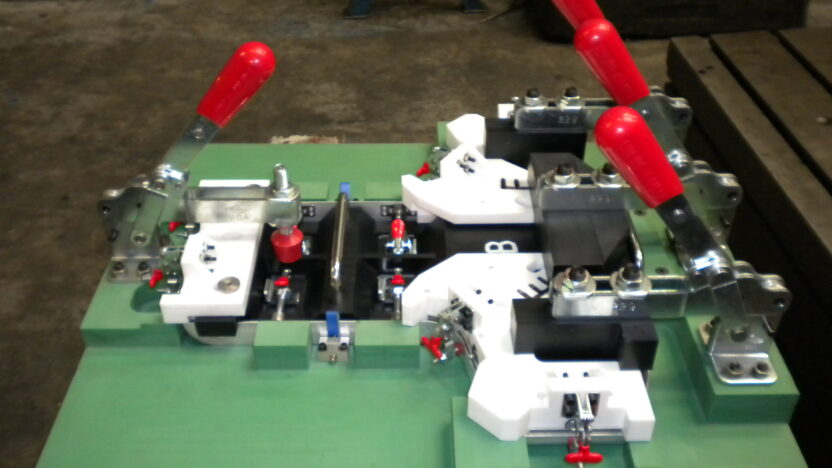When it comes to production lines, every second counts. One small misalignment or delay can snowball into bigger problems—lost time, wasted materials, and even product defects. That’s where assembly fixturing steps in. It’s the unsung hero behind efficient, high-quality manufacturing.
To learn more about how assembly fixturing can transform your production line, keep reading.
What is Assembly Fixturing?
Assembly fixturing refers to the use of customized tools or devices that hold parts in place during the manufacturing or assembly process. These fixtures ensure that components are aligned perfectly and held securely, so each operation—whether welding, gluing, screwing, or pressing—can be done consistently and accurately.
Think of them as the precision guides that make sure everything fits just right, every single time.
Why Assembly Fixtures Matter in Manufacturing
Without fixturing, operators have to manually align and hold parts—which is slow, inconsistent, and unsafe. With fixturing, you get:
- Faster assembly times
- Fewer errors and rework
- Improved part quality
- Safer work environments
- Repeatable, reliable output
It’s one of the simplest ways to add value without major investment or complex automation.
Types of Assembly Fixtures
Let’s break down the most common kinds:
1. Manual Fixtures
Simple, operator-assisted tools that hold parts in place. Great for low-volume or flexible production setups.
2. Pneumatic/Hydraulic Fixtures
Use air or fluid pressure to automatically clamp parts. Speeds up the process while reducing strain on workers.
3. Modular Fixtures
Made from adjustable components, these are ideal for prototyping or short production runs.
4. Automated Fixtures
Integrated into robotic cells or automated stations for fully hands-free operation.
Looking for options that fit your setup? Browse through high-performance assembly fixturing solutions tailored to any scale.
Top Benefits of Assembly Fixturing
Here’s what makes assembly fixturing a no-brainer in lean manufacturing:
- Speed: Reduce cycle time significantly by eliminating manual positioning.
- Precision: Keep tolerances tight and assembly flawless.
- Consistency: Every unit is built the same—perfectly aligned and secured.
- Operator Safety: Workers keep hands free from dangerous tooling zones.
- Cost Savings: Less rework, fewer rejects, and more uptime.
Where is Assembly Fixturing Used?
Fixturing has applications across industries, including:
- Automotive: Door panel assembly, frame welding, dashboard fitting.
- Electronics: PCB assembly, casing attachment, wire harnessing.
- Medical Devices: High-precision tool and implant assembly.
- Aerospace: Structural parts, fastener alignment, composite bonding.
- Consumer Products: Appliances, tools, and furniture.
Thanks to flexible assembly fixturing, even high-mix, low-volume operations can stay efficient and accurate.
Comparing Manual vs. Fixture-Assisted Assembly
| Feature | Manual Assembly | Fixture-Assisted Assembly |
|---|---|---|
| Speed | Slower | Much faster |
| Accuracy | Operator dependent | Consistently high |
| Training Needed | High | Moderate |
| Safety | Higher risk | Improved with hands-free design |
| Productivity | Inconsistent | Optimized and scalable |
Design Considerations for Effective Fixturing
Not all fixtures are created equal. A good fixture is:
- Rigid: No flexing or vibration during use.
- Accurate: Tolerances must match production needs.
- Ergonomic: Easy for operators to use and reload.
- Durable: Built to withstand your environment and production rate.
- Serviceable: Easy to maintain and modify if needed.
Work with experienced designers to ensure your fixture setup matches your product complexity and production goals.
Integrating Fixturing Into Automation
Want to take it further? Fixtures can be paired with robotics, conveyors, and sensors to create a fully automated assembly process.
For example, a robotic arm can load a part into a fixture, which then clamps automatically. Sensors confirm alignment, and a tool performs welding or fastening without human involvement.
That’s next-level efficiency—and it’s easier to implement than you might think with the right assembly fixturing strategy.
Fixturing and Quality Control
Fixtures not only assist in production but also help enforce quality:
- Built-in gauges can confirm part dimensions.
- Sensors can trigger alerts if a part is misaligned.
- Standardization ensures repeatability in quality checks.
With the right fixture, quality assurance becomes part of the process—not a step afterward.
Challenges in Fixturing (And How to Solve Them)
Here are a few common hiccups—and how to address them:
- Fixture Wear: Use durable materials and schedule regular inspections.
- Part Variation: Consider adjustable or modular fixture designs.
- Tooling Interference: Involve fixture design early in product development.
- Limited Space: Opt for compact or vertically stacked fixture layouts.
Talk to fixturing experts to tailor solutions for your product and space constraints.
Future of Assembly Fixturing
As manufacturing moves toward Industry 4.0, fixturing is getting smarter:
- Sensors & IoT: Fixtures can collect and send data for predictive maintenance.
- Digital Twins: Simulate fixture performance before production begins.
- Additive Manufacturing: Rapidly prototype custom fixture components.
- AI Integration: Optimize fixture use based on production data patterns.
These innovations make fixturing not just a support tool, but a data-driven engine for smarter manufacturing.
Final Thoughts
Assembly fixturing might not be flashy, but it’s absolutely foundational to streamlined, high-quality manufacturing. From speeding up production lines to reducing defects and injuries, fixtures provide the stability every operation needs.
Whether you’re just starting out or looking to scale up, investing in the right fixturing solutions can unlock massive improvements in productivity, consistency, and quality.
Start exploring advanced assembly fixturing options designed to match your pace and precision needs—and take the first step toward a faster, smarter, more efficient production line.



